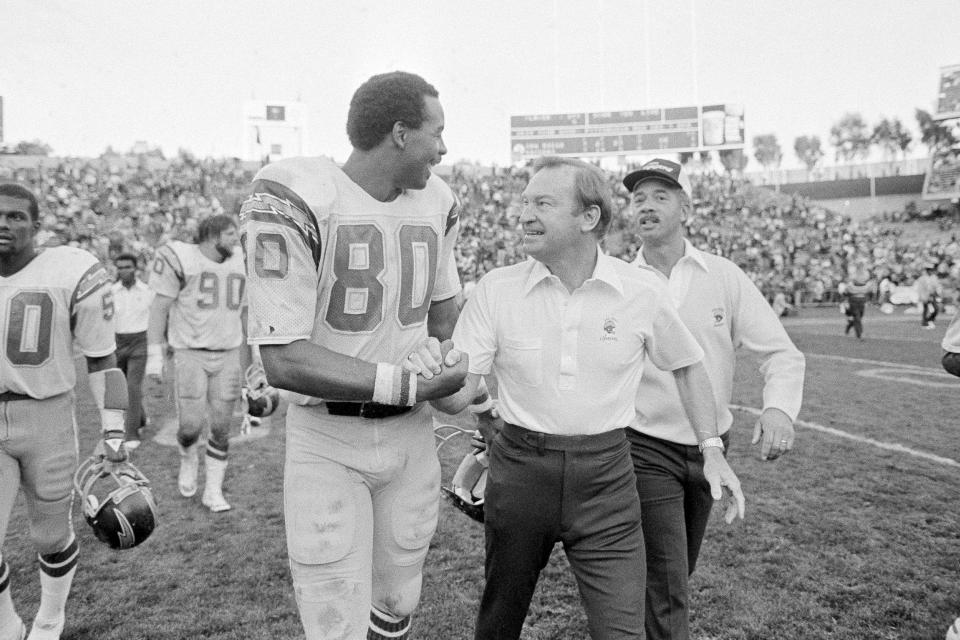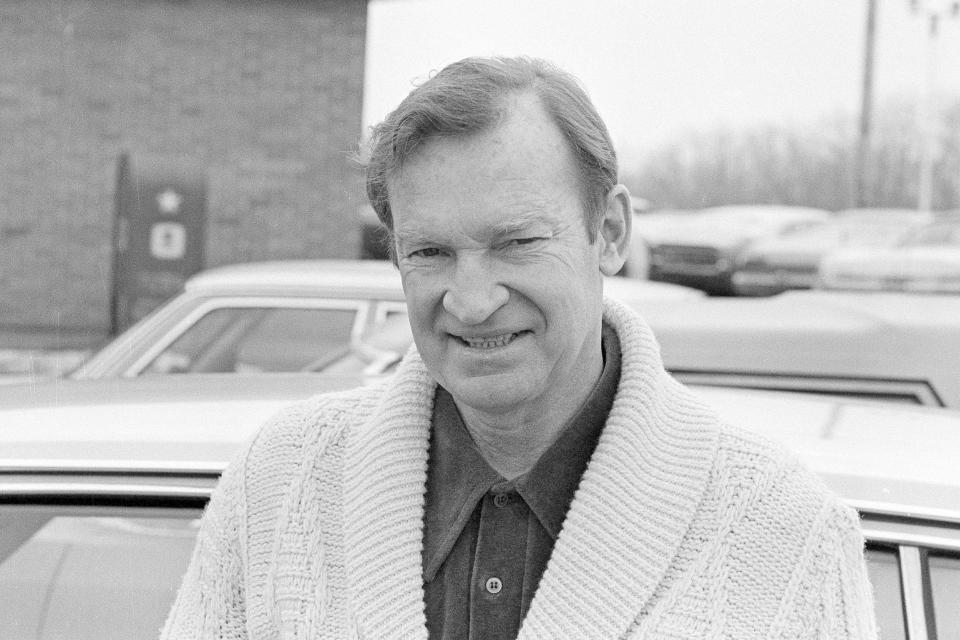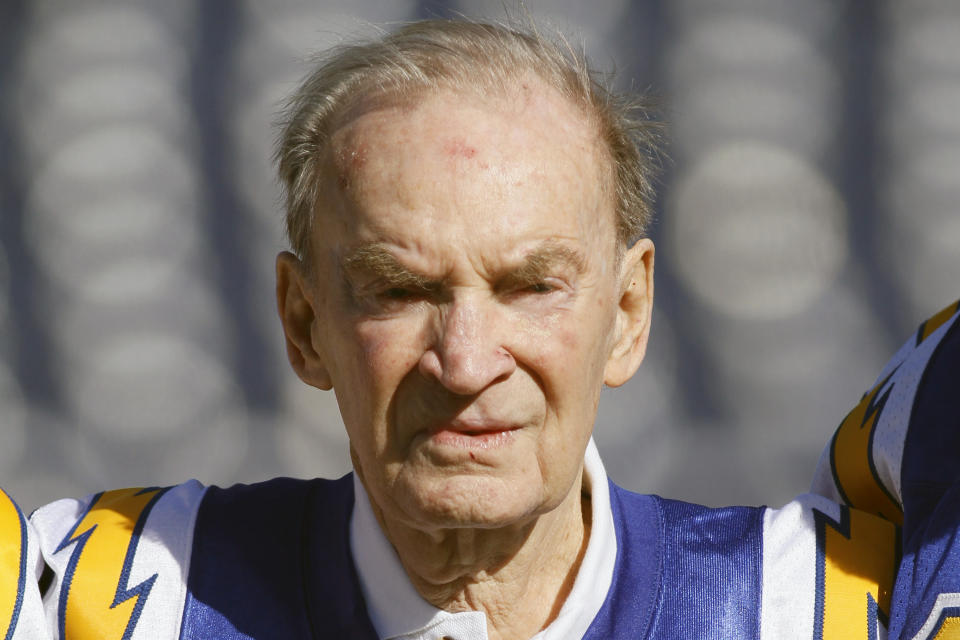Don Coryell finally reaches the Hall of Fame decades after his Air Coryell changed the NFL
- Oops!Something went wrong.Please try again later.
- Oops!Something went wrong.Please try again later.
- Oops!Something went wrong.Please try again later.
- Oops!Something went wrong.Please try again later.
- Oops!Something went wrong.Please try again later.
- Oops!Something went wrong.Please try again later.
SAN DIEGO (AP) — Nearly two weeks after Don Coryell died in 2010 at age 85, an impressive lineup of Hall of Famers gathered to remember the innovative coach whose "Air Coryell" offense produced some of the most dynamic passing attacks in NFL history.
John Madden, Dan Fouts and Joe Gibbs sat in the front row. Kellen Winslow and Charlie Joiner were also there.
They had either played for or coached under Coryell, and while remembering the coach’s genius and genuineness, the overwhelming sentiments were sadness and bewilderment that Coryell had yet to join them in Canton, Ohio.
It was enough to make Madden choke up as he began his eulogy.
“You know, I’m sitting down there in front, and next to me is Joe Gibbs, and next to him is Dan Fouts, and the three of us are in the Hall of Fame because of Don Coryell,” Madden said, his voice cracking. “There’s something missing.”
What many people have long considered a snub will be rectified Saturday when Coryell is enshrined in the Pro Football Hall of Fame.
“It’s wonderful because it’s so deserving,” said Fouts, the quarterback who made Air Coryell fly with the San Diego Chargers in the late 1970s and early 80s. “Unfortunately, it took this long, but it did. But he’s in and he’s going to be in forever and that’s the important thing.”
Fouts, who was inducted into the Hall of Fame in 1993, thinks Coryell kept missing the cut for Canton until now because of the lack of Super Bowls on his resume.
Coryell went 111-83-1 combined in five seasons with the St. Louis Cardinals and nine seasons in San Diego. The Chargers made it to the AFC championship game in consecutive seasons but lost both times, to the rival Oakland Raiders after the 1980 season and then to the Cincinnati Bengals in the infamous “Ice Bowl” the following season.
But his influence on the game remains unmistakable.
“You can just see when it changed and how it changed,” Fouts said. “I think Kellen Winslow put it best: Look at the television contracts.”
During the Air Coryell years, Fouts and the Chargers — who wore lightning bolts on their helmets, jerseys and pants — set records and led the NFL in passing almost every season while revolutionizing the game and thrilling fans.
“He made it fun,” Fouts said from his Oregon home. “Obviously when you’re having success, it’s fun. The system gave us success and knowing that, he was willing to be creative and innovative and trust his players. He let us give input and once you give a player input, that player plays harder to make that input work. He recognized that and he was so honest.”
At the height of Air Coryell, Fouts led the NFL in yards passing for four straight seasons and touchdown passes in consecutive seasons. Coryell would split Winslow, the tight end, and running backs out wide. Coryell’s schemes stretched the field and used motion, forcing defenses to play catch-up.
In 1979, Fouts, Winslow and John Jefferson posed for a Nike poster wearing bomber jackets, with footballs raining from the sky and the headline "Bombs Away."
“Don once said, ‘If we’re asking Kellen to block a defensive end and not catch passes, I’m not a very good coach,’ ” former running back and special teams star Hank Bauer once recalled.
One of the lasting images of the Coryell years was an exhausted Winslow being helped off the field by two teammates after the Chargers’ epic 41-38 overtime victory in the playoffs over the Miami Dolphins on Jan. 2, 1982. Despite cramping up in the heat and humidity, Winslow caught 13 passes for 166 yards and a touchdown, and also blocked a potential game-winning field goal.
As an example of how Coryell’s passing innovations eventually spread throughout what had been a run-first NFL, Fouts pointed out that the 1972 Miami Dolphins clinched the only perfect season in NFL history by beating Washington in the Super Bowl with Bob Griese throwing just 11 passes, completing eight for 88 yards. The Dolphins were otherwise powered by running backs Larry Csonka, Jim Kiick and Mercury Morris. Twelve seasons later, Miami’s Dan Marino became the first quarterback in NFL history to throw for 5,000 yards.
“So the thing is, Coryell believed in the passing game and he led the revolution,” Fouts said.
Coryell coached at San Diego State from 1961-72 and went 104-19-2. Gibbs played under Coryell and was on his staff with Madden for three years. Coryell left the Aztecs for the St. Louis Cardinals in 1973. With Jim Hart at quarterback, the Cardinals won division titles in 1974 and ’75 under Coryell.
Gibbs coached the Washington Redskins to three Super Bowl titles and reached a fourth, while Madden, who died in 2021, won one Super Bowl with the Oakland Raiders.
The Chargers hired Coryell on Sept. 25, 1978, the same day a Pacific Southwest Airlines jet crashed into San Diego's North Park neighborhood after colliding with a small plane, killing all 137 people on the two planes and seven people on the ground.
“You know what a horrible day that was for everybody,” said Fouts, who remembers seeing debris and smoke from the crash while driving from a radio appearance to the stadium that morning for the first team meeting with Coryell. “The day before was just a miserable game against the Packers and we were 1-3. So anyway, it turned out OK for the players.
“It was like this breath of fresh air came into the room and made everybody feel good,” Fouts said.
Alex Spanos, who bought the Chargers in 1984, fired Coryell midway through the 1986 season after a 1-7 start.
Coryell never coached again.
___
AP NFL: https://apnews.com/hub/NFL



